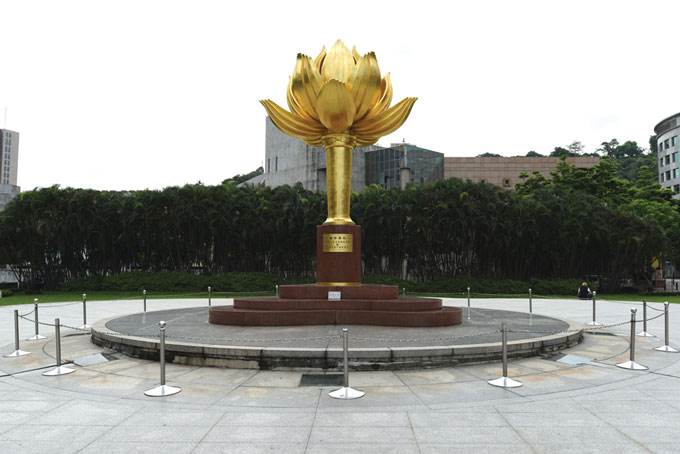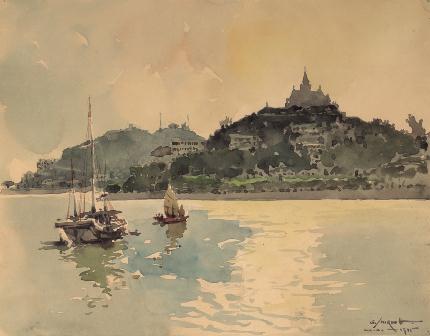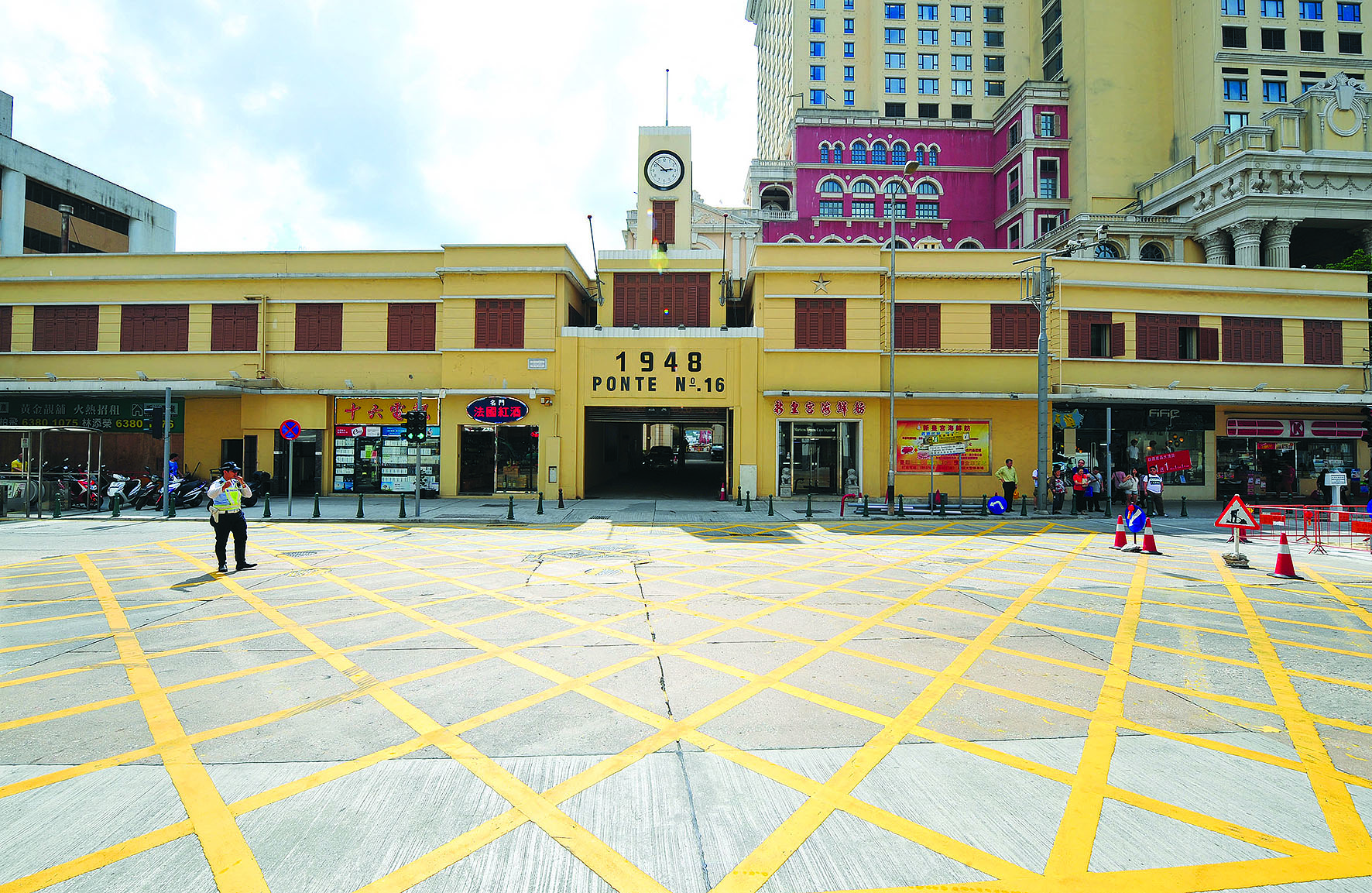
Affection for the Macao Basic Law
The Basic Law is the fundamental charter for the Macao Special Administrative Region, as it safeguards national sovereignty and territorial integrity, and at the same time it endows Macao with high degree of autonomy. The formation of the Basic Law has deep historical roots and important practical significance. The route connects a systematic series of buildings and sites winding through the historical changes and political developments for the last hundreds of years in Macao history. The route also demonstrates Macao’s prosperity and stability which are protected under the Basic Law.

Footprints of Painter Gao Jianfu
For anyone who would like to learn from the history and culture of Macao, the best way is to take a walk along its avenues and alleyways to follow the footprints from bygone eras. So let’s embark on a journey along the life of Gao Jianfu, a renowned painter who had a short stay in Macao, to take a retrospective look at the history of arts in Macao.

Footprints of Painter George Smirnoff
For anyone who would like to learn from the history and culture of Macao, the best way is to take a walk along its avenues and alleyways to follow the footprints from bygone eras. So let’s embark on a journey along the life of George Smirnoff, a renowned painter who had a short stay in Macao, to take a retrospective look at the history of arts in Macao.

Distinctive Old Shops
There are many streets of historic and cultural value located in the old town area of Macao. They used to be lined by shops in the hustle and bustle of the city in the past. For tourists and locals who wish to learn from antiquity, they can take a walk along these streets and have a look at the distinctive old shops to have a clue to the origin and evolution of local grass roots culture and the traditions practiced by these shops.

Footprints of Chinese Merchants of Macao
You are cordially invited to come with us on a journey to dig deep into the life of many reputable Chinese merchants of Macao in the different bygone eras, to have a taste of the history and culture embodied in these streets.

The Lou Kau Family
The Lou Kau family had been one of the most important Chinese families in the history of Macao. Its mansion and landscaped garden are well-preserved until the present with the former being a part of the Historic Centre of Macao and the latter opened to the public for leisure. For those who wish to learn about the family history of Lou Kau, the best way is to search for historic monuments associated with the family and find out how the family went through different eras, as they bear witness to the changes of the family and the historical vicissitudes of Macao.

Charitable Organizations
Along the history of Macao, the government did not have a comprehensive welfare system. The poverty-stricken multitude could only turn to local organizations for help to remain self-sufficient. This route is a trail that takes visitors to learn about the historic transition of the charitable organizations and to appreciate their great philanthropic significance.

Temples of Taipa
With a history of more than two hundred years, the Old Taipa Village is one of the significant parts of Macao rich in history and cultural resources, where regional customs at the beginning of the last century are still retained today. The temples in the Village have housed many precious cultural relics which are worth promoting to the public. Visitors can uncover serenity and savor antiquity along the route to different temples in Taipa, exploring the religious diversity of the local population.

Memorable Buildings of Coloane
With a history of over three hundred years, the old town of Coloane is a favorite tourist destination to uncover the serenity pervading the historical buildings of Coloane and savor antiquity along the route to explore the old town of Coloane.

Journey to the Village Community of Mong-Ha District
The Mong-Há Village, also known as Vong-Há Village, was the largest amongst the eight villages of Macao Peninsula back in the past. It was founded as early as in 1386, during the reign of Emperor Hongwu of Ming dynasty, according to extant documentation. Allegedly, the name, “Mong-Há”, has the implication of “looking to Xiamen city in the far distance”. At the time of its heyday, the village had over 130 streets and alleys, with an area covering today’s Rua de Francisco Xavier Pereira, Rua da Madre Terezina, Avenida do Coronel Mesquita, Avenida do Ouvidor Arriaga, Travessa do Pano, Travessa do Búzio and Beco do Caracol.
The content of the pair of couplets inscribed on to the door of the ancestral hall of Ho’s clan of Mong-Há Village revealed that most of its inhabitants came from Xiamen city of Fujian province. There were over 500 households, with the Chiu, Ho, Shum, Vong and Hui clans being the most populous and having their own ancestral hall. The Ho’s clan had the biggest population amongst all. The sightseeing route of this itinerary takes visitors on a tour of the once thriving Mong-Há Village to gain an insight to its historical evolution.
The content of the pair of couplets inscribed on to the door of the ancestral hall of Ho’s clan of Mong-Há Village revealed that most of its inhabitants came from Xiamen city of Fujian province. There were over 500 households, with the Chiu, Ho, Shum, Vong and Hui clans being the most populous and having their own ancestral hall. The Ho’s clan had the biggest population amongst all. The sightseeing route of this itinerary takes visitors on a tour of the once thriving Mong-Há Village to gain an insight to its historical evolution.

Lifestyle in “Pátios” and “Becos”
“Pátios” and “becos” are the lowest existing level of roads in Macao. In the past, most local residents lived in buildings in such “pátios” and “becos” where they would set up tables and chairs in the public space between the buildings for eating, playing and chatting. This is how they would maintain close contact and connection with their neighbours. This route links a series of characteristic “pátios” and “becos” in an attempt to evoke memories of those bygone days and help residents revive their collective memories of the past.

Rockscapes along the Southern Coastline of Coloane
Coloane houses most of the natural rockscapes of the outlying islands of Macao with many bizarre and well-known rocks scattered across its terrain. These natural formations which stand in different postures and having a close resemblance to the shapes of animals are closely associated with the history, legends and folkways of Coloane Island. They are a part of Macao’s admirable landscape and alive in the collective memories of the people for their indispensability in the origination of the customs practiced by the islanders.

Engaging Features of Lin Kai District
People have a natural propensity to settle down by the waterfront, and so did the residents of San Kio district in the past. By then, the livelihood of the residents was closely associated to Lin Kai (Lotus Stream) that flowed through the district. The farmers grew crops along its shores and fishermen sundried their fishing nets and implements over there. Others engaged in divination and prayed to the deities venerated in the temple adjacent to it for blessings. The everyday life of the residents was very easy-going and peaceful. But alongside socio-economic development, the stream was disappeared due to land reclamation and roads were built. The lifestyle of the residents that used to live along its shores changed inevitably and the surrounding buildings were reconstructed. The sightseeing route of this itinerary starts with the site of the Lin Kai and probes into the way how the residents of this district adapt to the changes in their environment over time.

Public Parks and Gardens of Macao
Much like the city itself, the public parks and gardens of Macao are inevitably a mix of cultural flavors. Of these green open spaces where people enjoy some leisure time and moments of relaxation, there are ones under Portuguese architectural influence and others of traditional Chinese-style courtyard layout. They are a unique cityscape of Macao, being an epitome of the confluence of Chinese and Western cultures.

Footprints of Poets of Modern Macao
Since centuries ago, Macao had been the place where many men of letters and refined tastes took residence or refuge. It was also a destination for sightseeing and business affairs. Allegedly, Portuguese poet Luís Vaz de Camões was the first visitor who sojourned in Macao and Tang Xianzu, a playwright and poet of Ming dynasty, was the first Chinese who wrote poems about the city.
Whenever there happened to be a shift in political power in China, many of its renowned poets would make their way to Macao. During the late-Ming dynasty, there were Tian Ran, Shi Jishan, Dan Gui, Qu Dajun, Wu Yushan and Wu Li. In the late-Qing dynasty, there were Dai Honghui, Wang Zhaoyong, Wang Zhaoquan, Zhang Xuehua, Wu Daorong, Liang Qinggui and Cui Siguan. After the Republican China was founded, Feng Qiuxue, Feng Yinxue, Liang Yanming, Zheng Zheyuan, Xian Yuqing, Zhao Liancheng and Shang Yanliu took up residence in Macao.
Whenever there happened to be a shift in political power in China, many of its renowned poets would make their way to Macao. During the late-Ming dynasty, there were Tian Ran, Shi Jishan, Dan Gui, Qu Dajun, Wu Yushan and Wu Li. In the late-Qing dynasty, there were Dai Honghui, Wang Zhaoyong, Wang Zhaoquan, Zhang Xuehua, Wu Daorong, Liang Qinggui and Cui Siguan. After the Republican China was founded, Feng Qiuxue, Feng Yinxue, Liang Yanming, Zheng Zheyuan, Xian Yuqing, Zhao Liancheng and Shang Yanliu took up residence in Macao.

Military Vestiges of Macao
After settling in Macao, the Portuguese began to construct fortifications and defense works of varying scale across the city, like the city wall and fortresses. The military structures (tunnels and fortifications), armaments and military training for soldiers in Macao were modernized with the advent of industrial revolution and modernization. A club was set up for servicemen and a military-themed museum was built. Over the centuries, Macao is left with plenty of military sites whose layout and features are less known to outsiders since military issues were treated as highly confidential in the past. Today, we can embark on this journey to unravel the hidden secrets behind these military facilities.

Footprints of Eminent Historical Figures of Macao
There are many great names in Macao throughout its history, like the local-born Xian Xinghai, Zheng Guanying who had settled down in Macao, Robert Morrison who took Macao as his base for career development and the sojourner Matteo Ricci. All of them had impregnated the city with traces of their presence which are well worth a look into for gaining a glimpse of their legendary life.

“Accidental Encounter・Seacoast”Series - Scenescape of Interior Harbor
Back in the old days, the Interior Harbor was pivotal to the foreign trade of Macao and had played an important role in the city’s urban development. The location of it used to be the North Bay and Shallow Bay. In the “Scenescape of Interior Harbor” of the “Accidental Encounter・Seacoast” Series, participants shall gain a sense of the historical vicissitudes of Macao over the centuries. They will be drawn to the scenic vistas, featuring the most characteristic old buildings along the Port area, as they embarked on this well-planned out tour.

“Accidental Encounter・Seacoast”Series - Seafront of Macao in the Old Days
Seemingly, there is always an interwoven relationship between urban development and the seacoast. In the case of Macao, after the Portuguese set foot on the city in mid-16th century and began its seafaring trading in the Far East, Macao turned out to be an entrepot through coastal trade. Important business activities first concentrated along the coastline and gradually spread to the inland areas. Over the past century, land reclamation took place along the city’s coastal line to cope with the need of urban development and turned the littorals into a variety of districts. The “Accidental Encounter・Seacoast” Series - Seafront of Macao in the Old Days walks participants through a well-organized tour of districts, characteristic architecture and traditional shops seated along the seafront of Macao, to show them the unique charms of the city. With the thoughtful itinerary, they can take an insider look at the hidden historical gems of the old downtown and feel the local touch of their residents.




